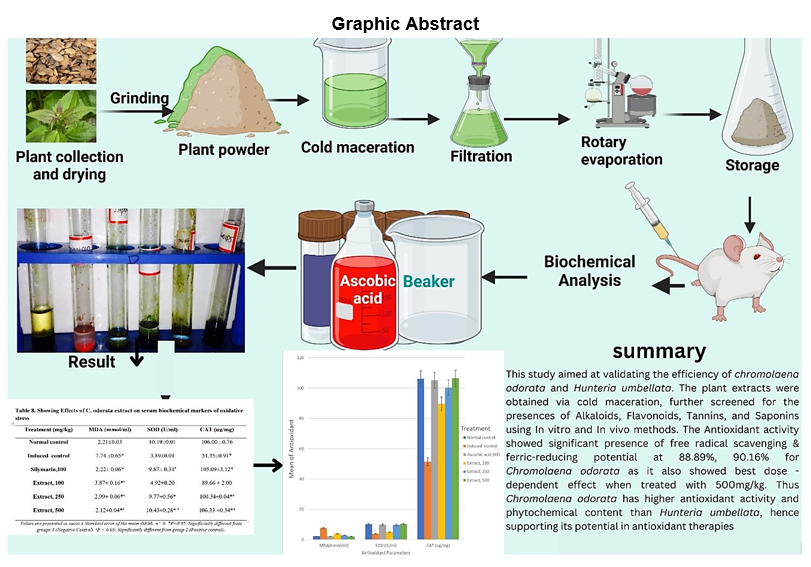Phytochemical and Antioxidant Evaluations of Chromolaena odorata and Huntaria umbellata
Ikechukwu Lucky Eze *
Department of Pharmacognosy and Traditional Medicine, Faculty of Pharmaceutical Sciences, Nnamdi Azikiwe University Awka, Nigeria.
Felix Ahamefule Onyegbule
Department of Pharmaceutical and Medicinal Chemistry, Faculty of Pharmaceutical Sciences, Nnamdi Azikiwe University Awka, Nigeria.
Christopher Obodike Ezugwu
Department of Pharmacognosy and Environmental Medicine, University of Nigeria Nsukka, Nigeria.
Johnson Victor Chibuzor
Department of Pharmacognosy and Traditional Medicine, Faculty of Pharmaceutical Sciences, Nnamdi Azikiwe University Awka, Nigeria.
Omoirri Moses Aziakpono
Department of Pharmacology and Toxicology, Faculty of Pharmaceutical Sciences, Federal University Oye-Ekiti, Ekiti State, Nigeria.
*Author to whom correspondence should be addressed.
Abstract
With the increasing demand for herbal medicine, it is imperative to validate the presence of the most anticipated antioxidants present in plants, which motivated the aim of this study. Hence, the efficacy of Chromolaena odorata and Hunteria umbellata were validated. Natural antioxidants in medicinal plants, such as polyphenols and flavonoids, mitigate oxidative stress and serve as alternative treatments for various diseases. We obtained crude extracts through cold maceration and qualitative and quantitative phytochemical screenings for alkaloids, flavonoids, tannins, and saponins. Antioxidant profiles were assessed using DPPH and FRAP assays for In vitro and MDA, SOD, and CAT assays for In vivo. The liquid (ethanol) extracts from these plants were tested to confirm the presence of alkaloids, flavonoids, saponins, tannins, and glycosides in the ethanol extracts of Chromolaena odorata leaves and Hunteria umbellata seeds. The decreasing effect of DPPH experienced in both plant extracts validates the presence of free radical scavenging activities and ferric-reducing antioxidant potential in a concentration-dependent manner. Chromolaena odorata demonstrated superior inhibition in both DPPH (88.89 ± 0.26%) and FRAP (90.16 ± 0.76%) assays compared to Hunteria umbellata. In vivo studies showed dose-dependent antioxidant effects, with 500 mg/kg of Chromolaena odorata exhibiting the best results across MDA, SOD, and CAT indices. This study concludes that Chromolaena odorata leaves possess higher antioxidant activity and phytochemical content than Hunteria umbellata seeds, supporting their potential use in antioxidant therapies.

Keywords: Phytochemical, antioxidant, Chromolaena odorata, Hunteria umbellate, In vitro, In vivo, acute toxicity, oxidative stress
